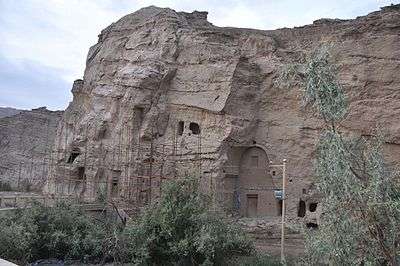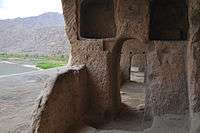Kumtura Caves


The Kumtura Thousand Buddha Caves (Chinese: 库木吐喇千佛洞; pinyin: Kùmùtǔlǎ Qiānfódòng) (also Qumtura) is a Buddhist cave temple site in the Autonomous Region of Xinjiang, China. The site is located some 25 km west of Kucha, Kuqa County, on the ancient Silk Road.[1][2] 112 cave temples survive, dating from the fifth to the eleventh centuries. Damaged during the Islamic conquests and subsequently by occasional habitation after abandonment of the site, Kumtura was visited by a number of the early foreign expeditions to Chinese Central Asia, including the 1902 Ōtani expedition, Oldenburg, and Le Coq.[3][4][5][6] The last detached several wall paintings and took them back to Berlin (now at the Museum für Asiatische Kunst).[7]
Construction of the Dongfang Hong Hydroelectric Plant in the 1970s caused the water level of the Muzat River to rise and has increased the rate of decay of the wall paintings.[1] Long-term preservation measures under the auspices of UNESCO began in 1999 with extensive documentation and survey work and consolidation of the conglomerate rock from which the caves are excavated.[1][8] The site was among the first to be designated for protection in 1961 as a Major National Historical and Cultural Site.[9] In 2008 Kumtula Grottoes was submitted for future inscription on the UNESCO World Heritage List as part of the Chinese Section of the Silk Road.[10]

See also
References
- 1 2 3 Agnew, Neville, ed. (2010). Conservation of Ancient Sites on the Silk Road: Proceedings of the Second International Conference (PDF). Getty Conservation Institute. pp. 37–9. ISBN 9781606060131.
- ↑ Wang Weidong, ed. (2008). 库木吐喇石窟内容总录 [A general record of the Kumtura caves] (in Chinese). 文物出版社. ISBN 9787501023844.
- ↑ "Japanese Collections". International Dunhuang Project. Retrieved 28 April 2012.
- ↑ "Russian Collections". International Dunhuang Project. Retrieved 28 April 2012.
- ↑ "German Collections". International Dunhuang Project. Retrieved 28 April 2012.
- ↑ Hopkirk, Peter. Foreign Devils on the Silk Road: The Search for the Lost Cities and Treasures of Chinese Central Asia. University of Massachusetts Press. ISBN 0870234358.
- ↑ "MIA Kumtura Collection". University of Washington. Retrieved 28 April 2012.
- ↑ "The Conservation and Restoration of Kumtura Thousand Buddha Caves". UNESCO. Retrieved 28 April 2012.
- ↑ "国务院关于公布第一批全国重点文物保护单位名单的通知 (1st Designations)" (in Chinese). State Administration of Cultural Heritage. 3 April 1961. Archived from the original on 9 June 2012. Retrieved 28 April 2012.
- ↑ "Chinese Section of the Silk Road". UNESCO. Retrieved 28 April 2012.